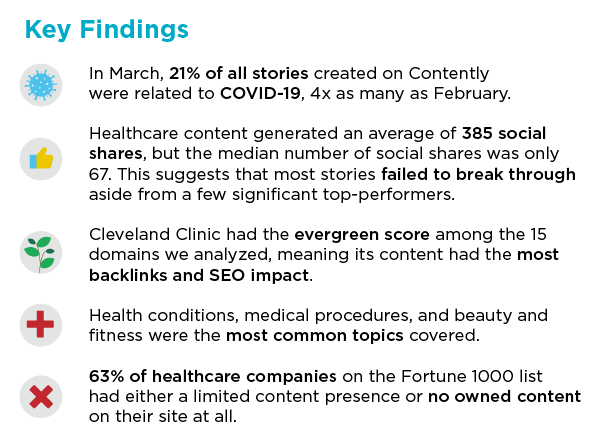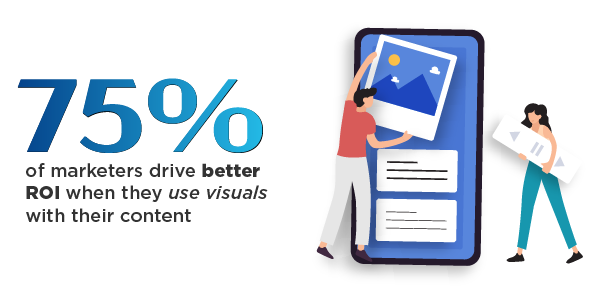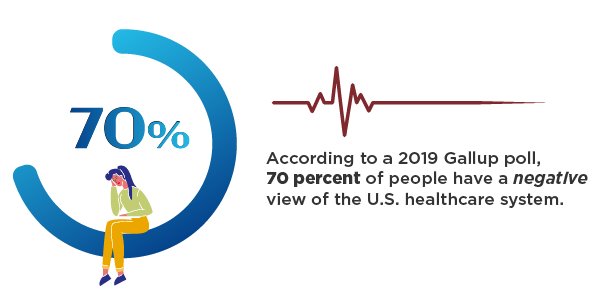ROI
State of Healthcare Content Marketing: 5 Trends Transforming the Industry
Around 430 BCE, a Greek man named Hippocrates became a doctor. In addition to treating patients and making discoveries, Hippocrates also spent part of his career working on some of the most important medical documents ever published. Look no further than the Hippocratic oath, the code of ethics for physicians that bears his name.
Over 2,400 years later, technology, science, and medicine have evolved exponentially, but many words in the oath are still remarkably relevant: “I will remember that there is art to medicine as well as science, and that warmth, sympathy, and understanding may outweigh the surgeon’s knife or the chemist’s drug.”
Good medicine, like good content, comes down to trust and results. That was true before the common era began. But the rise of digital health content has complicated the way people think about healthcare.
Every day, Google handles more than 1 billion health questions. However, over a third of U.S. adults have low health literacy. And according to a recent Weber Shandwick survey of 1,700 adults, 52 percent are concerned today’s health-related information is either false or misleading.

So it’s never been easier to search and find health content online. Yet that same content can be incorrect, promotional, contradictory, or overly complex. In the midst of a global pandemic, that trend is only going to increase as people look to learn about the latest symptoms, diagnoses, and treatments.
Where are patients supposed to turn? More importantly, what should doctors, hospitals, insurers, and healthcare companies do to improve the state of healthcare content online?
That’s what we’ve set out to answer in this report. We’ve extracted the most important healthcare content marketing trends using a combination of quantitative and qualitative data. We spoke to industry experts, analyzed macro content trends using our in-house content strategy technology, and highlighted companies creating great content. We also identified common challenges while explaining ways healthcare marketers could overcome them.
Like Hippocrates said, medicine is an art and a science. The same holds true for healthcare content. Let this be your prescription for success.
[If you prefer to view a PDF version of the report that’s easier to print, we’ve got you covered here.]
Methodology
Research for this report was compiled in May 2020. We analyzed 1,551 pieces of healthcare content using StoryBook, Contently’s content strategy tool, which measures top-performing topics, formats, social shares. The dataset includes 15 healthcare companies that publish content—none of which are Contently clients.
We also pulled some industry-level benchmarks, measured by Contently’s content marketing platform. This data looks at all content produced by our clients in the spring of 2020.
(To dive deeper on these findings, sign up for our live webinar on the state of healthcare content marketing. You’ll also get the webinar on-demand.)
5 Trends Shaping the Healthcare Industry
- Timely COVID Stories Perform Best, but They Have to Be Done Right
- Healthcare Is Playing Catch-Up, but There’s a Playbook They Can Follow
- Telemedicine + Healthtech Companies Are Leading the Field
- CSR Is a Popular Use Case That Often Lacks Creativity
- Reports + Data Are the Biggest Differentiators
1. Timely COVID Stories Perform Best, but They Have to Be Done Right
A global pandemic impacts everyone and everything. As cases started to spike, it wasn’t long before it seemed like every article, video, and social post tied back to the coronavirus.
For many companies, especially in healthcare, covering the topic was vital. They had an obligation to share their knowledge with the public. For others, though, it was just another trending topic to jump on. Even if it comes from a good place, we don’t need an email from a car dealership that says they’re “here for us during these troubling times.”
To gauge the immediate impact on content creation, we pulled the stories created by our clients across all industries and then tagged any that mentioned relevant terms like “pandemic,” “Covid,” and “quarantine.” In March, content related to the coronavirus accounted for 21 percent of all stories across all industries, a significant increase up from roughly 6 percent in February. The rate held steady through April until dipping slightly in May.

The surge in new content proved to be an interesting case study for healthcare publishers. There’s an overabundance of health content online, but it mostly consists of evergreen information on established domains like WebMD and Livestrong. These sites live off of consistent search traffic, but they typically don’t connect to the news cycle. Once the coronavirus hit, that all changed.
Since great storytelling thrives on specifics, other brands had a new opportunity to create timely content. Some of the top-performing stories in our dataset came from companies putting a unique spin on the public conversation.
For example, in late March, Cleveland Clinic published “Here’s the Damage Coronavirus Can Do to Your Lungs” with expert quotes and a link to a new video featuring an experienced lung pathologist. It was shared over 26,000 times on Facebook. Cigna ran an early how-to story on proper handwashing technique that generated thousands of shares. In April, 23andMe wrote about a research study it was working on to look at the connection between genetics and COVID-19.
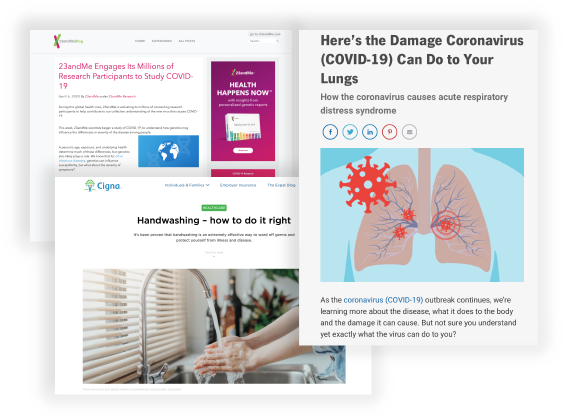
If healthcare companies hope to compete with the WebMDs of the world, they have to drive awareness first with these kinds of original stories. Then, once they build trust and increase domain authority, they can fill in their output with more clinical, encyclopedic content.
However, that doesn’t mean healthcare brands should start pursuing journalistic content. These stories lead to conflicts of interest. Plus, brands usually don’t have the resources or infrastructure in place to go after hard news. However, they can break new ground and build an audience simply by reporting on the research and innovations being developed inside their own company.
“In the health category, there’s no such thing as a generalist … think about what your audience is searching for,” said Amy O’Connor, editor-in-chief of Healthination. “Unless you’re like AP or Reuters, it’s really hard to cover the news, and nobody wants you to, because it’s already out there.”
Your time and money would be better spent using trending topics as a springboard to provide insights and analysis the public can’t get anywhere else.
2. Healthcare Is Playing Catch-Up, but There’s a Playbook They Can Follow
The year 2000 feels like a different lifetime. Y2K was supposed to shut down society, the Human Genome Project was completed, and Contently’s co-founders were in high school.
So much has changed in the two decades since. For starters, technology survived the new millennium, and our co-founders graduated (we think?). But if you work in healthcare marketing, life might not look all that different.
“The rule of thumb is that it’s usually twenty years behind,” O’Connor said. “There are certainly exceptions, but one of the reasons it’s twenty years behind is because there are so many rules and regulations about how—can speak to consumers.”
That mindset still holds back many of the industry’s top brands across the globe. Seventy-two healthcare companies qualified for the Fortune 1000 list in 2020. They all earned at least $2 billion in revenue last year. However, 15 of them had no content presence whatsoever like a blog or resource center on their websites, while 30 more had extremely limited content outputs such as corporate newsrooms or bare blogs hidden in the footer of their sites.
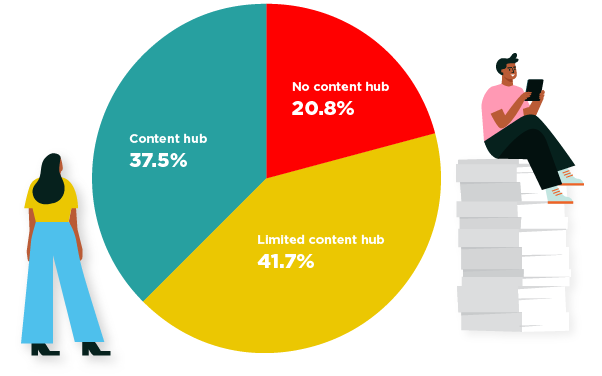
This missed opportunity to build trust and reach new patients and customers is holding back these companies from moving up the list.
Right now, TV commercials are the most visible (and expensive) form of healthcare marketing. Total ad spend on pharma commercials topped $3.7 billion last year, according to ad tracker iSpot.tv, which is why it seems like the same drug clips play on a loop regardless of when or what you’re watching. In some cases, pharma companies spent hundreds of millions of dollars in a single year to market their treatments. AbbVie topped the list by doling out $465 million to promote Humira.
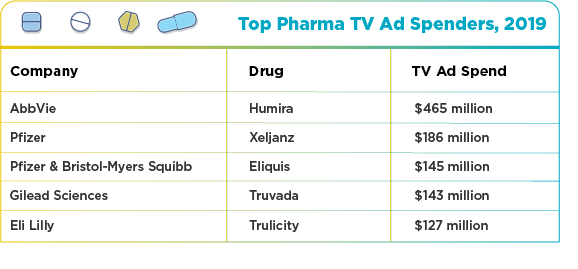
That system, however, is ripe for change. For starters, traditional TV viewership continues to drop as our media habits evolve. The commercials themselves lack creativity and don’t have enough air time to provide meaningful insights or specifics. And over the last decade, the American Medical Association has repeatedly called for a ban on all consumer ads from companies selling drugs or devices.
Companies can reroute part of these massive budgets to digital content that helps educate consumers while staying within industry rules and regulations. We know they’re capable of this because as the coronavirus spread, almost all of the healthcare brands on the Fortune 1000 list updated their sites and social channels with useful updates—even if they had no other content on their sites whatsoever. The announcements, letters, videos, and articles showed that healthcare companies could adapt quickly if the situation calls for it.
And as marketers revisit their plans for the future, how they allocate budgets for different programs is changing. LinkedIn recently reported that 78 percent of marketers expect budgets for online content to increase as a result of the pandemic.
“Have someone who is a content expert craft the engaging, effective, high-impact story. But work with a medical expert who can fact-check and reality-check what you’re writing,” O’Connor said. “That partnership can really enrich your content. It’s also really important for SEO. Google has higher standards for content that affects your health.”
Other industries like finance and technology are known for sophisticated content programs that build trust and boost the bottom line; there’s no reason healthcare can’t join their ranks. In fact, some companies are already leading the way.
3. Telemedicine and Healthtech Companies Are Leading the Field
Oscar, founded in 2012, has a very simple tagline: “Health insurance made easy.” Those four words tell us exactly what to expect whether we’re visiting Oscar’s brightly colored site for the first time or looking through its robust resource center.
That mission stands out because very few things about the healthcare system deserve to be described as “easy.” Science is complex, sure, but many healthcare companies have struggled to communicate complicated topics to a general audience. Low health literacy plagues millions of people across the world. In “The Great American Search for Healthcare Information,” Weber Shandwick discovered that 31 percent of adults found health information hard to understand.
From our research, it was clear that a new breed of healthcare company is rising through the industry. Digital-first brands in sectors like telemedicine and healthtech see content as a competitive advantage.
In some ways, organizations like Oscar, Epic, and athenahealth are acting more like tech companies than legacy healthcare brands. These newer players developed tools like Open Enrollment checklists and interactive Flu Dashboards to inform the public and heighten goodwill.
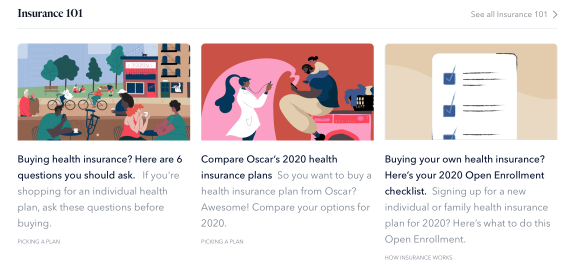
Site design is a significant factor here since it impacts how audiences find your content. As Contently VP of marketing Joe Lazauskas argued a few years ago, many Fortune 1000 brands have content hubs that look like they haven’t been updated since 1998—if they have any content at all.
“If the design of a content site is terrible, people won’t give the words a chance,” he wrote. “They’ll perceive it all as low quality.”
According to Stanford’s Persuasive Technology Lab, 46 percent of people believe that “design look” is the number one indicator of a brand’s credibility. It affects everything from time spent on your site to bounce rate to conversions.
Creating visual content also tends to give newer healthtech firms a leg up on legacy companies. Animated videos and infographics, for instance, can make a site come across as more innovative and trustworthy. Seventy-five percent of marketers drive better ROI when they use visuals with their content, according to a joint study we did with Libris in 2019. And content with a video element was eight times as engaging as purely written content.
“Complex topics, simple execution,” O’Connor said. “The more complicated and inaccessible you’re making your content, the less you’re serving your audience. Break it down so anyone in the sixth grade can read and comprehend and take action.”
RealSelf, which helps people find doctors and cosmetic surgeons online, has taken this advice to heart. Its content hub makes use of a simple layout and pastel aesthetic that resembles an Instagram feed (which is likely part of the reason its content generated hundreds of backlicks in our report, second only to Cleveland Clinic.)
It’s actual Instagram feed, meanwhile, is full of short videos that demystify procedures like tattoo removals and botox. Captions complement the visuals with key details like average cost, user ratings, and a brief breakdown of the science involved. These posts regularly rack up over 50,000 views.
https://www.instagram.com/p/B_NcsRThvfm/
We expect visual content and thoughtful design will only increase as time goes on. And you don’t have to be a healthtech startup to reap the benefits. During the pandemic, there’s been a surge of coronavirus graphics from publishers and healthcare companies alike that break down complex concepts for visual learners.
On this front, the Center for Health Care Strategies (CHCS) offers resources for improving health literacy through content. The CHCS advocates for elements like white space, clear language, bullets, and more. To simplify information, they even reference tools like the Flesch-Kincaid Grade Level test, which measures readability, and Sustainability Assessment of Materials (or SAM), which looks at areas like graphics, layout, and cultural appropriateness.
4. CSR Is a Popular Use Case That Often Lacks Creativity
The healthcare industry has a bit of an image problem. The U.S. spends more on healthcare than any other country, costs have increased more than 30x since the 1970s, yet we still have one of the lowest life expectancies compared to other developed countries.
According to a 2019 Gallup poll, 70 percent of people have a negative view of the U.S. healthcare system. To counter this narrative, a lot of healthcare companies have focused their content marketing efforts on corporate social responsibility.
This tactic makes sense on the surface, but companies could do a better job developing their CSR efforts into engaging stories that audiences can find. During our research, we discovered that this kind of content was often buried in corporate newsrooms. (Some newsroom pages could only be accessed by scrolling to the footer of the site.) In terms of creative value, CSR stories tend to have the dry tone of a press release.
Publishing this kind of content doesn’t have to be rocket science. CSR topics actually have a more natural fit in healthcare than other industries. Given all of the crucial research and development that healthcare companies are working on, it doesn’t feel as forced to talk about the impact on the community. These companies are saving lives. That makes for a compelling story–as long as you tell it the right way.
Just look at what GE Reports has done.
Over the last decade, GE Reports has become arguably the best brand blog there is. Led by former Forbes editor Tomas Kellner, the content hub highlights inspirational work carried out by GE employees around the world. It’s CSR content on steroids with the polish of a journalistic outlet.
For example, when there was a ventilator shortage, the GE healthcare team sprang into action, using 3D printing technology to increase production in Wisconsin. Naturally, Kellner and his team sprang into action as well, telling an inspirational story that makes GE look good without overt self-promotion.
“The time your audience spends with your content is really a transaction,” Kellner told us last year. “You have to give them back something of value. If the content becomes too promotional, too self-serving, you will lose your audience very quickly.”
Also worth noting: There has never been a better time to be a healthcare publisher. Audiences are hungry for uplifting healthcare stories, especially when there’s a shortage of good news to go around.
Epic, a B2B healthcare software company, has also been active on this front. In addition to webinars and whitepapers about managing COVID-19 care, the company has also profiled a rural Pennsylvania healthcare system helping patients prepare for their first telehealth appointments.
Patient stories are another CSR initiative gaining momentum in the industry. Think of them like case studies from the patient’s perspective that reveal the journey someone took to overcome health issues.
Patient stories should appeal to healthcare marketers because they’re driven by a clear story. They’re also inherently accessible, offering a personal touch that stands out among the complex, clinical info we’re used to.
The key, though, is figuring out how to tell the story respectfully. Some patients will feel comfortable crafting their own experiences while others may want an experienced creator to translate their thoughts.
“To find patient advocates, social media is a great tool,” said Nancie George, head of content at Oshi Health, which specializes in digestive healthcare. “It’s really about working with people who have identified themselves as an advocate and want to be contacted to share their story.”
5. Reports + Data Are the Biggest Differentiators
As the saying goes, write what you know.
If you’re starting from scratch, trying to compete with established content hubs can seem overwhelming. But most companies have a hidden content advantage sitting right in front of them: their own data.
In data-driven industries like healthcare and finance, internal information is a powerful differentiator. Most content adds to an existing dialogue, but proprietary research is newsworthy content. It creates a conversation, drives shares, and lends itself nicely to visual content. For that reason, it’s the easiest way to boost social engagement, press coverage, and backlinks.
In our research of healthcare content, original reports and guides emerged as some of the top-performing pieces that companies published.
Doctor on Demand has The State of Primary Care in America. ZocDoc launched a series called ZocTrends that reveals interesting data on patient behavior. Roman, the “digital health clinic for men” even named its content hub Health Guide. It’s steadily pumped helpful advice, analysis, and resources to patients. Its most recent project is the Novel Coronavirus Resource Hub, which compiles 18 pieces of content in one place, including a free telehealth assessment.
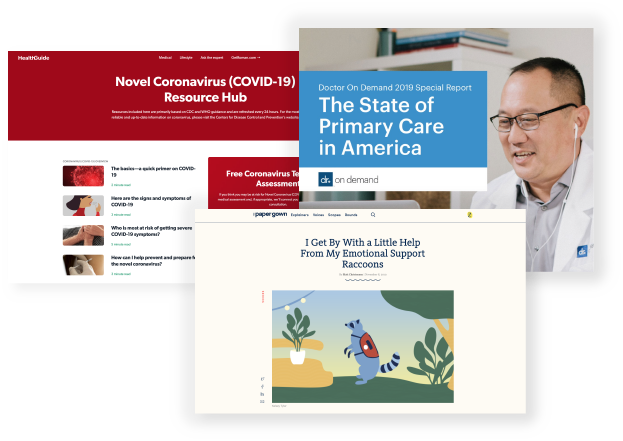
This strategy works so well for companies newer to content marketing because research can be dissected and repurposed for blog posts, e-books, animated explainer videos, and social graphics. So you don’t need a big marketing team or giant budget to make an immediate impact. Also, the results from these big rock projects can help convince internal stakeholders to increase their content investment.
“A few years ago, our company realized we were sitting on a treasure trove of data about healthcare in the U.S.,” John Fox, former executive director of content for athenahealth, wrote on our blog. “We decided to invest in building a robust research team to capture and serve up insights to our B2B clients in medical groups and hospitals.”
After studying electronic health records (EHR) at the state and national level, athenahealth launched the Flu Dashboard. Every year, it tracks the spread of flu over time in all 50 states with an interactive map. Users can also compare week-by-week flu visits and see vaccination trends.
According to Fox, athenahealth was able to notice flu trends faster for the Center for Disease Control and Prevention.
When the project took off a few years ago, the company doubled down on its content success. Since then, athenahealth has also developed dashboards for Lyme Disease and, more recently, COVID-19.
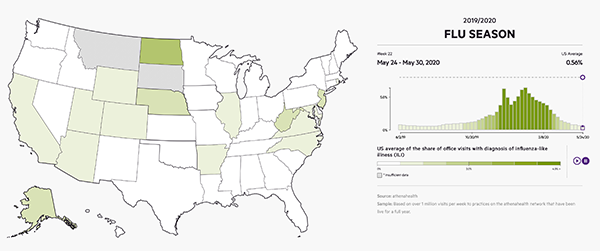
“We hire field-tested reporters who have a nose for great stories and aren’t shy about tackling complex topics or parsing data,” Fox explained. “With this approach, we’ve reported with original data on trending topics like the opioid crisis, Medicaid expansion under the Affordable Care Act, and the rush of IUD visits following the last presidential election. Our in-house designers are visual storytellers who can take in a data dump on chronic health conditions in the U.S. and turn out an interactive tool that demands exploration.”
Even corporate reports meant for shareholders could yield powerful stories that demand attention. Every year, Cleveland Clinic publishes its internal State of the Clinic report that rounds up data on patients and caregivers across its operations. Not all of the info is relevant to the public, but stats about a decrease in patient falls (down 15 percent) or an increase in virtual visits (up 29 percent) could easily be repurposed for a wider audience interested in healthcare.
When you’re turning data into content, make sure you use it responsibly. Improving health literacy takes more than just digestible information. Setting standards—and publicizing them in your work with research methodologies and sound sourcing—will go a long way toward building trust.
“Over the last decade, there are more points of view available in healthcare, which is both good and bad,” George said. “We’ve found internal reporting guidelines to be really helpful. It includes best practices like not overstating your findings, adding timestamps, using primary sources when possible. We have a big responsibility to the public.”
Get better at your job right now.
Read our monthly newsletter to master content marketing. It’s made for marketers, creators, and everyone in between.
